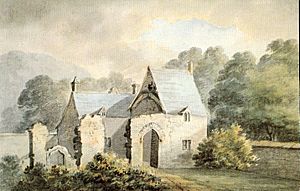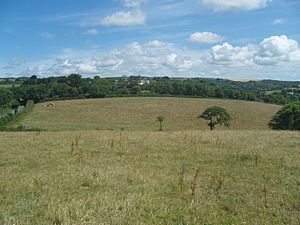James Chudleigh facts for kids
Colonel James Chudleigh (born around 1618 – died 6 October 1643) was an English soldier who fought during the First English Civil War. He first served the Parliamentary army and was put in charge of the troops in Barnstaple. He was a skilled leader and quickly rose through the ranks.
After being injured and captured by the Royalist army at the Battle of Stratton in May 1643, he switched sides. This might have happened because he was blamed for the defeat. His father, Sir George Chudleigh, who was also a Parliamentary commander, changed sides around the same time.
On 30 September 1643, Chudleigh was wounded during a Royalist attack on Dartmouth. He died from his injuries on 6 October.
Quick facts for kids
James Chudleigh
|
|
|---|---|

Chudleigh's birthplace, Ashton Manor, c. 1794
|
|
| Personal details | |
| Born | 1618 Ashton Manor, Devon |
| Died | 6 October 1643 (aged 25) Dartmouth, Devon, England |
| Cause of death | Gunshot wound |
| Resting place | St Saviours, Dartmouth |
| Relations | William Strode |
| Parents | Sir George Chudleigh; Mary Strode (1586–1645) |
| Occupation | Soldier |
| Military service | |
| Allegiance | |
| Years of service | 1641 to 1643 |
| Rank | Sergeant major general (Parliament); Colonel (Royalist) |
| Battles/wars | Bishops' Wars First English Civil War Braddock Down Sourton Down Stratton |
Who Was James Chudleigh?
James Chudleigh was the fourth of nine sons. His parents were Sir George Chudleigh and Mary Strode. His family was part of the gentry, which meant they were wealthy landowners in Devon.
James was born in 1618 at Ashton Manor. This estate had been in his family since 1320. His father was a Member of Parliament, a person elected to represent an area in the government. In 1622, his father also bought a special title called a baronetcy.
James's brothers likely did not take part directly in the Civil War. One brother, Thomas, served in Ireland. He later became a surgeon.
Early Military Career
We don't know much about James Chudleigh's early life before 1640. In that year, he became a Captain in the army. This army was raised for the Bishops Wars, which were conflicts between England and Scotland.
In 1641, he was involved in something called the Army Plots. This was a plan to take control of London and free a powerful prisoner. James was investigated but was released without being charged. He seemed to have only been a messenger.
Fighting in the Civil War
When the First English Civil War started in August 1642, Chudleigh tried to join the Royalist side. However, he was turned away because his father and uncle were known to support Parliament.
Instead, Parliament allowed him to gather 1,000 soldiers. He used these soldiers to protect Barnstaple in north Devon. During this time, he also oversaw the building of Chudleigh Fort near Bideford.
The Earl of Stamford, who was the Parliamentary commander in the west, made Chudleigh his deputy. Chudleigh was one of the few who fought well at the Battle of Braddock Down in January 1643, even though Parliament lost. On 21 February, he led a successful attack that captured Modbury. This village was important for the Royalists who were trying to capture Plymouth.
On 28 February, the two sides agreed to a local ceasefire. This truce ended on 22 April. Chudleigh gathered 1,700 troops near Launceston. The Royalist leader, Sir Ralph Hopton, had more than 3,600 men there.
Chudleigh attacked the next day, but the Royalists quickly recovered. Faced with more soldiers, Chudleigh's Parliamentary forces had to retreat to Okehampton. Chudleigh helped cover their retreat, making sure their cannons were saved.
On 25 April, Hopton marched towards Sourton Down. He planned to stay there for the night and attack Okehampton at dawn. Chudleigh learned that the enemy was very close. He also found out his cannons had been moved to Crediton.
To avoid losing his cannons, Chudleigh decided to ambush the Royalists with only 100 cavalry. It was night and a strong thunderstorm was happening. The Royalists panicked and ran away.
Even though Stamford was not at the Battle of Sourton Down, he was given credit for this victory. It was good news for Parliament in the west. Using information captured there, Stamford marched into Cornwall with 5,400 men.
Changing Sides
Despite being outnumbered, Hopton won a major victory at the Battle of Stratton on 16 May. This battle gave the Royalists control of Devon. Parliament's defeat was due to several reasons. These included the bravery of the Cornish soldiers and the absence of Parliament's cavalry.
Chudleigh had led an unwise counter-attack. It was successful at first, but it left the center of the Parliamentary army open to attack. Efforts to stop the collapse failed. Parliament lost 300 soldiers and 1,700 were taken prisoner, including Chudleigh.
Chudleigh was taken to Oxford, which was the Royalist capital. There, he switched sides. His reasons were explained in a Royalist leaflet published under his name. This showed how important he was to Parliament in Devon. Before Stratton, he had published a similar attack on the Royalists.
The Earl of Clarendon, a Royalist advisor, wrote that Chudleigh fought bravely until he was captured. Clarendon said Chudleigh changed sides because he believed it was the right thing to do.
Stamford escaped to Exeter, where Sir George Chudleigh was governor. The city surrendered in early September to Prince Maurice. James Chudleigh, now a Royalist Colonel, was part of Prince Maurice's army.
The soldiers in Exeter were given safe passage to friendly territory. Stamford returned to London. When he arrived, he claimed his defeat was because Chudleigh deserted during the battle. This is different from other reports that said Chudleigh was captured after being wounded. Stamford never led an army again, which suggests he was blamed for the defeat.
Sir George Chudleigh, James's father, resigned from his position. He said that while he supported law and religion, destroying a kingdom was not the way to save it. He stayed at Ashton Manor but did not take part in the fighting.
In September 1643, James Chudleigh took part in a Royalist attack on Dartmouth. According to Clarendon, he was wounded around 30 September and died a few days later. He was buried on 6 October in St Saviours church in Dartmouth.


